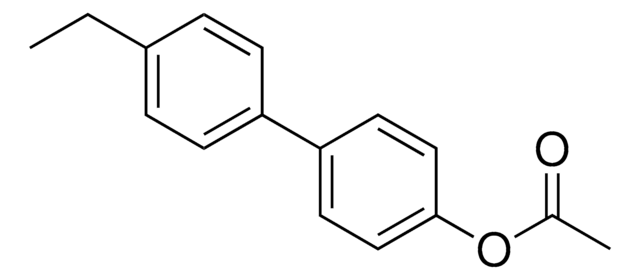196487
4-Biphenylacetic acid
98%
Seleccione un Tamaño
36,10 €
Seleccione un Tamaño
About This Item
36,10 €
Productos recomendados
Ensayo
98%
mp
159-160 °C (lit.)
solubilidad
DMSO: soluble 50 mg/mL, clear, colorless to yellow
cadena SMILES
OC(=O)Cc1ccc(cc1)-c2ccccc2
InChI
1S/C14H12O2/c15-14(16)10-11-6-8-13(9-7-11)12-4-2-1-3-5-12/h1-9H,10H2,(H,15,16)
Clave InChI
QRZAKQDHEVVFRX-UHFFFAOYSA-N
Información sobre el gen
human ... BAD(572)
¿Está buscando productos similares? Visita Guía de comparación de productos
Categorías relacionadas
Descripción general
Aplicación
Palabra de señalización
Danger
Frases de peligro
Consejos de prudencia
Clasificaciones de peligro
Acute Tox. 3 Inhalation - Acute Tox. 3 Oral - Eye Irrit. 2 - Skin Irrit. 2 - STOT SE 3
Órganos de actuación
Respiratory system
Código de clase de almacenamiento
6.1C - Combustible acute toxic Cat.3 / toxic compounds or compounds which causing chronic effects
Clase de riesgo para el agua (WGK)
WGK 3
Punto de inflamabilidad (°F)
Not applicable
Punto de inflamabilidad (°C)
Not applicable
Equipo de protección personal
Eyeshields, Faceshields, Gloves, type P2 (EN 143) respirator cartridges
Elija entre una de las versiones más recientes:
¿Ya tiene este producto?
Encuentre la documentación para los productos que ha comprado recientemente en la Biblioteca de documentos.
Filtros activos
Nuestro equipo de científicos tiene experiencia en todas las áreas de investigación: Ciencias de la vida, Ciencia de los materiales, Síntesis química, Cromatografía, Analítica y muchas otras.
Póngase en contacto con el Servicio técnico







![2-[2-(2-Chloroethoxy)ethoxy]ethanol 96%](/deepweb/assets/sigmaaldrich/product/structures/902/295/ff6d7bb1-a7e0-4582-86e1-819084626e67/640/ff6d7bb1-a7e0-4582-86e1-819084626e67.png)

